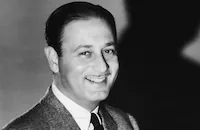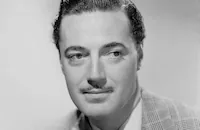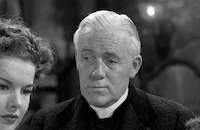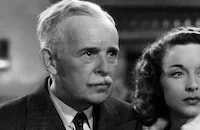Maisie Was a Lady

Brief Synopsis
Cast & Crew
Edwin L. Marin
Ann Sothern
Lew Ayres
Maureen O'sullivan
C. Aubrey Smith
Joan Perry
Film Details
Technical Specs

Synopsis
When drunken millionaire Bob Rawlston causes Maisie Ravier to ruin her carnival sideshow act, she is fired. Later, Bob lets the furious Maisie have his car to drive back to New York City. On the way, she is stopped by a motorcycle cop who recognizes the car and, thinking she has stolen it, takes her to jail. The next day, Bob cannot remember the previous night and refuses to press charges. As Maisie has been verbally abusive to the policeman and has no money or job, the judge threatens to throw her in jail, until a remorseful Bob admits that Maisie's version of the story is probably correct. The judge then orders Bob to employ Maisie for $25 a week for two months. Bob takes her to his family estate and hires her as a maid, impressing Maisie with his kindness. The head butler, Walpole, takes Maisie under his wing and tries to show her how to dress and act properly. The house is filled with guests, as Bob's sister Abby is about to celebrate her engagement to society playboy Link Phillips. Abby is very happy about the engagement, but is worried that her frequently absent father "Cap" will not arrive in time for the party. Maisie is convinced that all of the guests are "phonies," but Abby is kind and asks Maisie to become her personal maid. Maisie soon learns that Cap has rarely been with his children since his wife died many years before. His neglect has made Abby very lonely and insecure and led to Bob's drinking and giving up a promising career as an engineer. The night before the engagement party, Diana Webley, Link's former fiancée and a friend of Abby, arrives, secretly bent on stopping Link and Abby's marriage. At breakfast the next day, Link is unnerved by Diana's presence and quickly leaves. Meanwhile, Cap sends Abby expensive jewelry to make up for his not being there, something he has done repeatedly over the years. Link then convinces the distraught Abby to elope with him. Maisie, who has a "hunch" about Link, is dismayed. While Link is getting ready, Diana enters his room, leaving the door open. When Diana realizes that Link still wants to see her and is only marrying Abby for her money, she says that she has been a fool and wants to warn Abby. Just then Abby arrives and at first refuses to believe Diana, who says that all of Abby's friends have been laughing over Abby's blindness and stupidity about Link. Maisie arrives just as Diana reads a letter from Link in which he admits that money was his only reason for marrying Abby. Although Maisie tries to comfort Abby, she feels that no one has ever liked her and tries to poison herself. Sometime later, when Cap arrives, after being summoned by Walpole, Abby is still unconscious and near death. Cap tells Bob that he does not understand what is wrong and says that Abby has always been sweet, but not very attractive. When Maisie hears him talking so dispassionately, she laces into him about Bob and Abby, making him realize that he has been a negligent father. Now shocked into realizing what is wrong with their lives, Cap and Bob appeal to Abby, who soon recovers. Abby asks Maisie to be her companion, and Bob, realizing that he has fallen in love with Maisie, proposes, but she is sure that she could never be the lady of a house such as the Rawlstons' and leaves. Some time later, Bob locates Maisie at a vaudeville house and finally convinces her that she is a "lady," and she agrees to marry him.

Director

Edwin L. Marin
Cast

Ann Sothern

Lew Ayres

Maureen O'sullivan

C. Aubrey Smith

Joan Perry

Paul Cavanagh

Edward Ashley

William Wright
Edgar Dearing

Charles D. Brown

Joe Yule
Tim Ryan
Henry Blair

Billy Curtis
John Bambury

Walter Miller
Jerry Marenghi
Tommy Cotton
Jody Gilbert
George Guhl
Anne O'neal
Alice Keating
Charles Coleman
Barbara Bedford

Howard Hickman
Joe Devlin
Joan Blair
Jack M. Gardner
Cliff Danielson
Edward Smith
William Stelling
Philip Winter

Hans Conreid
Claire Owen

Hillary Brooke
Georgia Carroll
Kay Sutton
Doris Day
Gertrude Simpson
Milton Kibbee
Crew
Myles Connolly
Cedric Gibbons
Charles Lawton
Mary C. Mccall Jr.
Betty Reinhardt
Betty Reinhardt
Stan Rogers
J. Walter Ruben
Douglas Shearer
Fredrick Y. Smith
David Snell
Dolly Tree
Edwin B. Willis
Edward Woehler

Film Details
Technical Specs

Articles
Maisie Was a Lady
Sothern had appeared in a few films at the dawn of the sound era, before going to New York and becoming a success on Broadway. She returned to Hollywood in 1933, and carved out a minor niche for herself as a star of "B" films, first at Columbia, then at RKO. Frustrated by the quality of her films, she left RKO in 1938, holding out for better roles. Her break came when she was cast in the second lead as a wisecracking blonde in Walter Wanger's production, Trade Winds (1938). Sothern received excellent reviews, and attracted the attention of MGM producer J. Walter Ruben, who was casting Maisie (1939). The film had originally been intended for Jean Harlow, and had been shelved after Harlow died in 1937. When Ruben saw Trade Winds, he knew he had found his Maisie. The public agreed, and the modestly budgeted film grossed more than three times its cost.
"At 30, [Sothern] finds herself a find," according to Time Magazine. "As Maisie, she is a healthier Harlow, an untarnished Mae West." There would be ten Maisie movies between 1939 and 1947. Unlike other b-series, however, the Maisie films had no continuing characters other than Maisie. And unlike other series, this one did not serve as a launching pad for promising starlets. Most of the Maisie series co-stars were drawn from MGM's roster of established contract players. In Maisie Was a Lady, they included Lew Ayres, Maureen O'Sullivan, and C. Aubrey Smith. On the next film in the series, Ringside Maisie (1941), Sothern would meet her second husband, co-star Robert Sterling.
Maureen O'Sullivan had put her career on hold in 1940, after war broke out in Europe. Her husband, director John Farrow, had enlisted in the Royal Canadian Navy, and O'Sullivan and the couple's infant son went with him to Canada. She returned to Hollywood after four months to appear in Maisie Was a Lady, then rushed back to her husband's side. She worked on another Tarzan movie after Farrow went to sea, but asked to be released from her contract in 1942 when he became ill with typhoid. O'Sullivan resumed her career after the war, but with her family growing (the couple had seven children), her film and television appearances were sporadic.
Maisie Was a Lady was one of Lew Ayres' rare excursions away from his own hugely successful MGM "B" series, the Dr. Kildare films. But war would soon bring a change in his professional fortunes. Ayres alienated moviegoers when he declared himself a conscientious objector and refused to fight. Although he served quietly as a medic and a chaplain under fire with troops in the South Pacific, Ayres found film roles scarce after the war. His best post-war part was as the sympathetic doctor in Johnny Belinda (1948), which earned him an Academy Award nomination.
Sothern's career was booming in the 1940s, thanks to the Maisie films. She had signed an MGM contract after the first one, which required her to appear in at least one Maisie picture per year. "I felt she was a millstone around my neck at times," Sothern later recalled. But it was a millstone she used to her advantage, to get MGM head Louis B. Mayer to cast her other films. "I'd tell Mr. Mayer to give me a musical, and I'd do another Maisie. We'd bargain in that way." That's how she got to do such "A" films as the musicals Lady Be Good (1941) and Panama Hattie (1942), and the drama Cry Havoc (1943). When her film career faded in the early 1950s, Sothern turned to television, and starred in two successful comedy series, Private Secretary (1953-57) and The Ann Sothern Show (1958-61). She was also featured in the TV sitcom, My Mother the Car (1965-66), as the voice of the talking car.
Director: Edwin L. Marin
Producer: J. Walter Ruben
Screenplay: Elizabeth Reinhardt, Mary C. McCall Jr., based on a story by Betty Reinhardt, Myles Connolly from a character created by Wilson Collison
Cinematography: Charles Lawton Jr.
Editor: Fredrick Y. Smith
Cast: Ann Sothern (Maisie Ravier), Lew Ayres (Bob Rawlston), Maureen O'Sullivan (Abigail Rawlston), C. Aubrey Smith (Walpole), Edward Ashley (Link Phillips), Joan Perry (Diana Webley), Paul Cavanagh (Cap Rawlston).
BW-79m. Closed captioning.
by Margarita Landazuri

Maisie Was a Lady
TCM Remembers - Ann Sothern
TCM Remembers - Ann Sothern
Quotes
Trivia
Notes
A Hollywood Reporter production chart lists Rita Johnson and Henry O'Neill in the cast, but they did not appear in the released film. The CBCS erroneously lists the surname of the family as "Bigelow" instead of "Rawlston," and lists "Diana's" surname as "Winters" instead of "Webley." Reviews noted that this was the first of the "Maisie" films in which the title character was involved in a serious romantic relationship at the end of the film. This was also the first film in the series not based on a novel or story by Wilson Collison. On November 24, 1941, Ann Sothern, Lew Ayres and Maureen O'Sullivan recreated their roles for a Lux Radio Theatre version of the film. For additional information on the series, please consult the Series Index and the entry for Maisie (1939) in AFI Catalog of Feature Films, 1931-40; F3.2662.















